Putting Up a Sectional Mast
This really is easier that it might seem, if you know how to do it. Here’s my technique:
Required materials
- bundle of mast sections
- 3 guy ropes. I try to make mine at least twice the height of the mast, but 1.5 times can work. One long rope can replace two shorter ones if it is tied in the center.
- 3 guy anchors. These might be stakes, trees, fence posts, or whatever you can tie to.
- enough space to set it up
Preparation
Tie the guy ropes to the top mast section. They need to be tight enough that they don’t slip down the mast. There are many ways to do this, such as using a guy ring.
Estimate where two of your anchor points will be, and tie the ends of two guy ropes there. On flat ground, the distance between them will be roughly 1.2 to 1.7 times the height of the mast. You can make final adjustments once the mast is up. You will want to have a clear space to work about twice the height of the mast on one side of the line between these two points. (Note: you can use trigonometry to calculate the exact positions of the guy anchors and lengths of the ropes if you always install the antenna on a flat, open field. I generally am not setting up antennas in such places, and have to use whatever anchors are available.)
Erection
- Walk the top mast section away from the two guy anchors to the ends of the guy ropes. Ideally you can lean the mast against the two ropes and have it stay in place. However, if the ropes are too heavy, you might need to pick up the top section and add another section on the bottom. But, at some point, you should be able to lean the mast against the two guy ropes and have it stay up, although not vertical.

2. Pick up a mast section in one hand. Reach down and pick up the bottom of the mast with the other hand, moving a little bit towards the guy anchors as you do this, so the mast is always leaning slightly against the ropes.
3. Once you get the mast up high enough in the air, insert the new section onto the bottom of the mast, then set the mast down on the ground, still leaning slightly against the ropes. If you have more than one person, you can have one person holding and inserting the new section, and others using both arms to raise the mast. (More than 2 or 3 people just get in the way.)
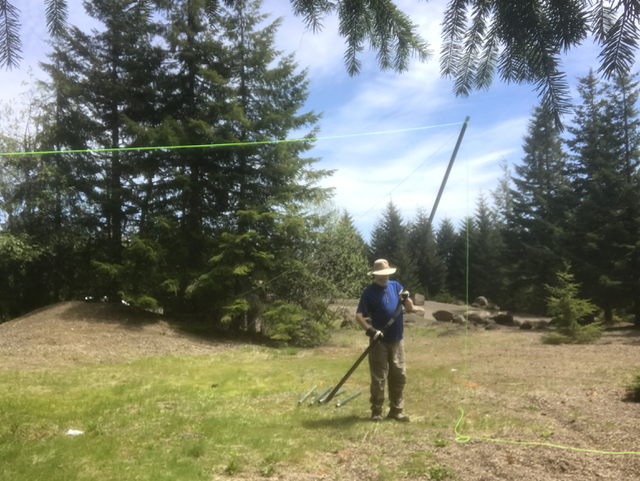
pick up the 2 sections with one hand, add the 3rd section on the bottom with the other hand, while keeping the mast leaning against the two ropes 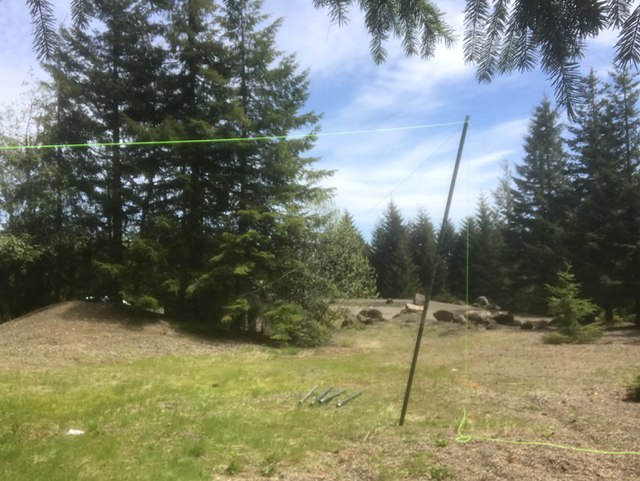
mast with 3 sections, leaning against two guy ropes
4. Repeat steps 2 and 3 until you have added all the sections. Each time, the mast moves a little closer to the guy anchors as it gets taller. The important thing is to move it just enough that it leans, but not too much, so the guy ropes always keep it from falling over. If you find you need to reposition a guy rope or anchor, make whatever adjustments you need as you go along.
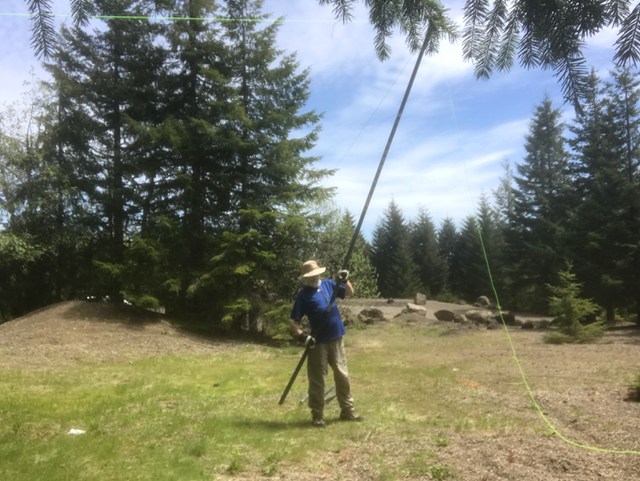
adding the 4th section 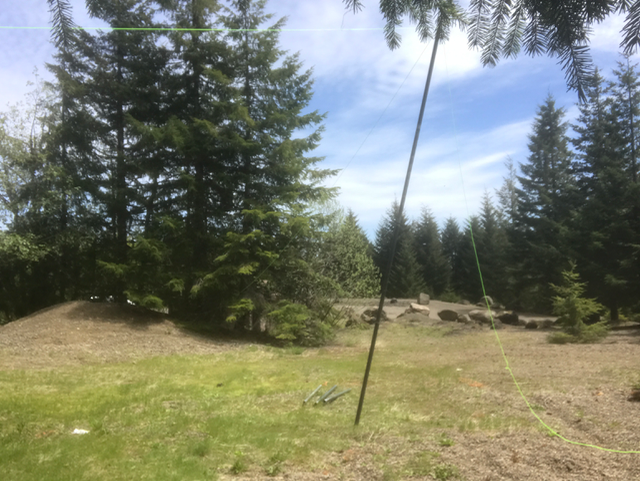
mast with 4 sections 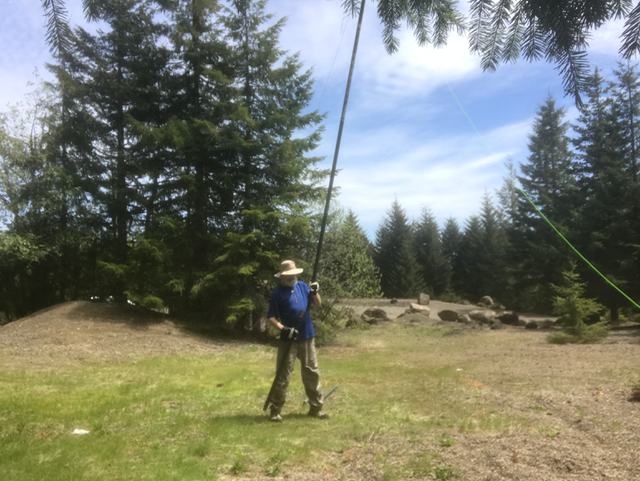
adding the 5th section 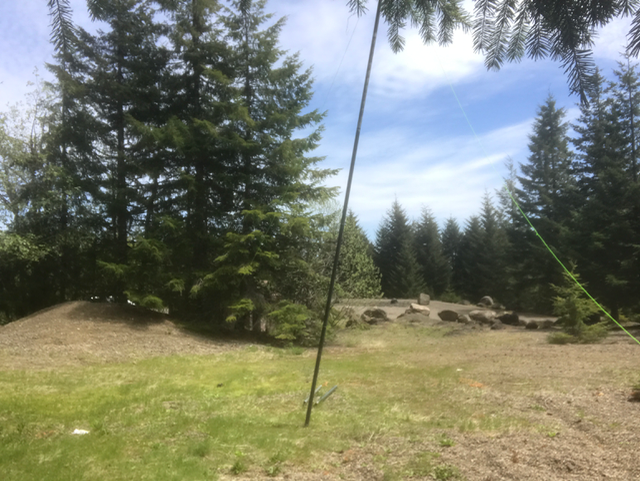
mast with 5 sections 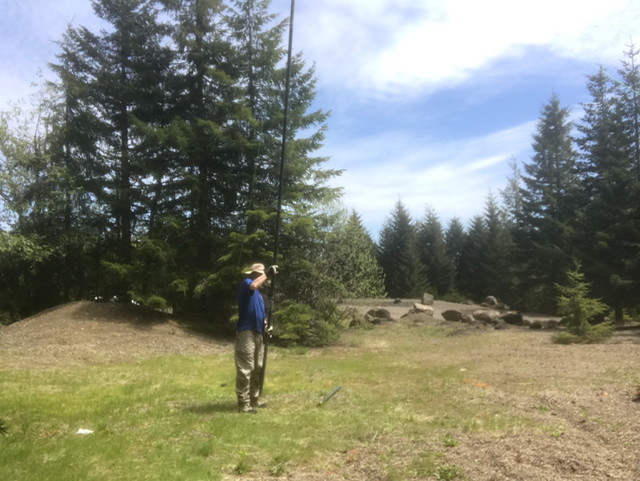
adding the 6th section 
all 7 sections up, with the guy ropes tied off. Notice how far to the left the mast has moved since the first photo
5. Secure the third guy rope to its anchor. Try to have the guy ropes spaced equally around the mast. You can use 4 guy ropes if you prefer, but just use two of them for the erection process. In the photos above, the 9 m (28 ft) mast moved about 3 m (10 ft) in the process of putting it up. (It moves faster as it gets taller – watch out with the last 2 sections!)
6. If the mast is not straight, or in the wrong position, adjust the guy ropes and anchor points as needed. You can pick up the base of the mast and move it sideways if the guy ropes have a bit of slack – they will still prevent it from falling over as you do so.
7. Once you have the mast where you want it and the guy ropes tied off, lower the mast, add whatever antenna you want on top, and put the mast up again. Don’t forget the coax to the antenna, and, for a beam, a rope on one end of the boom to rotate it.
Disassembly
Taking down the mast is very easy if the sections aren’t stuck together: grab the mast just above the bottom joint and pick it up. The bottom section should fall out. Lower the mast slowly, keeping it leaning against two guy ropes, as it slips down through your hands. As your hands pass each joint the bottom section should drop out. (You can pull it free if it sticks.) It is just a matter of moving horizontally at the correct speed to keep the mast leaning slightly against the ropes as you lower it.
How Easy is it?
One year at Field Day everyone else was busy, so I decided to see if one person could erect a mast with a triband HF yagi on top. While I think I could have done it by myself, someone else volunteered to help me, and I was happy to accept their offer. But two of us easily put the TA-33jr up 9 m (28 ft), using the heavy-duty 1.2m (4 ft) military aluminum mast sections. I have put the fiberglass sections up to 12 m (40 ft) by myself before, but they won’t handle the weight of the beam, and should be guyed at 2 levels.
At my Field Antenna Workshops, everyone who has tried it has been able to put up a mast to 9m (28 ft), even those who are considerably shorter and not as strong as I am.
It takes practice to be good at it. The critical piece is judging how far to move horizontally as the mast is raised (or lowered) to keep the right tension on the ropes. The mast feels different in your hands as it approaches the tipping point.
If the mast starts to fall, just get out of the way and let it go: that’s one reason why the antenna on top is added after the mast has been set up initially in the right position. But the only time the mast has fallen that I know of was when someone untied a guy rope by mistake when they were taking it down. I had to repair a trap and replace a piece of plastic pipe that the antenna was mounted to, but we’ve used the same antenna several years since then.